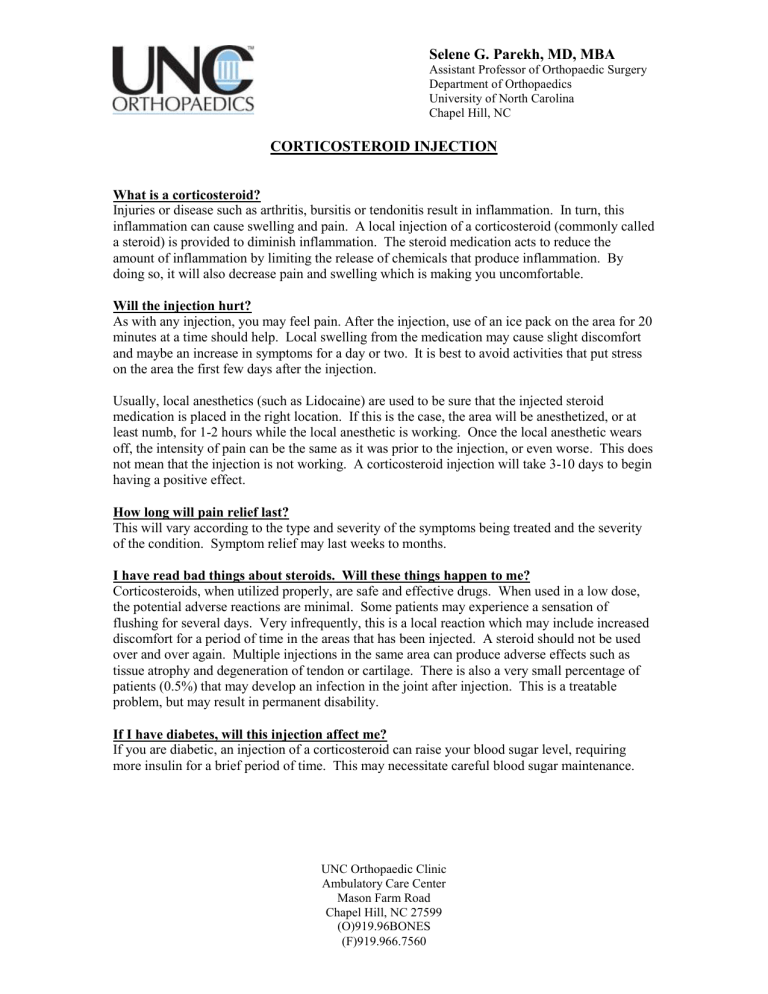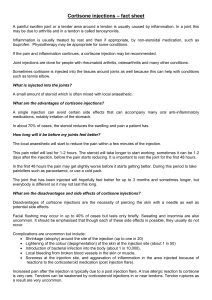CORTICOSTEROID INJECTION

Selene G. Parekh, MD, MBA
Assistant Professor of Orthopaedic Surgery
Department of Orthopaedics
University of North Carolina
Chapel Hill, NC
CORTICOSTEROID INJECTION
What is a corticosteroid?
Injuries or disease such as arthritis, bursitis or tendonitis result in inflammation. In turn, this inflammation can cause swelling and pain. A local injection of a corticosteroid (commonly called a steroid) is provided to diminish inflammation. The steroid medication acts to reduce the amount of inflammation by limiting the release of chemicals that produce inflammation. By doing so, it will also decrease pain and swelling which is making you uncomfortable.
Will the injection hurt?
As with any injection, you may feel pain. After the injection, use of an ice pack on the area for 20 minutes at a time should help. Local swelling from the medication may cause slight discomfort and maybe an increase in symptoms for a day or two. It is best to avoid activities that put stress on the area the first few days after the injection.
Usually, local anesthetics (such as Lidocaine) are used to be sure that the injected steroid medication is placed in the right location. If this is the case, the area will be anesthetized, or at least numb, for 1-2 hours while the local anesthetic is working. Once the local anesthetic wears off, the intensity of pain can be the same as it was prior to the injection, or even worse. This does not mean that the injection is not working. A corticosteroid injection will take 3-10 days to begin having a positive effect.
How long will pain relief last?
This will vary according to the type and severity of the symptoms being treated and the severity of the condition. Symptom relief may last weeks to months.
I have read bad things about steroids. Will these things happen to me?
Corticosteroids, when utilized properly, are safe and effective drugs. When used in a low dose, the potential adverse reactions are minimal. Some patients may experience a sensation of flushing for several days. Very infrequently, this is a local reaction which may include increased discomfort for a period of time in the areas that has been injected. A steroid should not be used over and over again. Multiple injections in the same area can produce adverse effects such as tissue atrophy and degeneration of tendon or cartilage. There is also a very small percentage of patients (0.5%) that may develop an infection in the joint after injection. This is a treatable problem, but may result in permanent disability.
If I have diabetes, will this injection affect me?
If you are diabetic, an injection of a corticosteroid can raise your blood sugar level, requiring more insulin for a brief period of time. This may necessitate careful blood sugar maintenance.
UNC Orthopaedic Clinic
Ambulatory Care Center
Mason Farm Road
Chapel Hill, NC 27599
(O)919.96BONES
(F)919.966.7560




